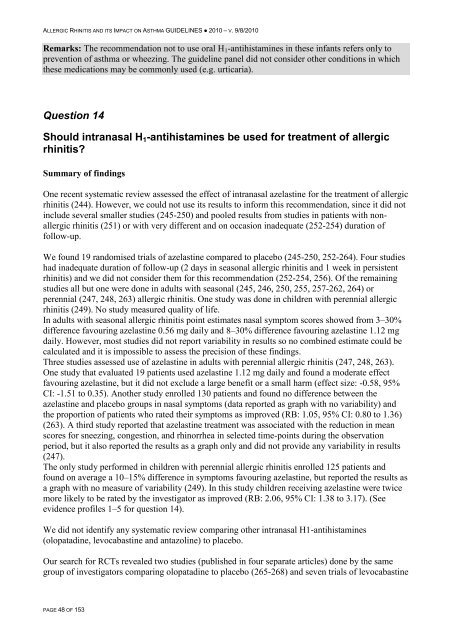Allergic Rhinitis and its Impact on Asthma - ARIA
Allergic Rhinitis and its Impact on Asthma - ARIA
Allergic Rhinitis and its Impact on Asthma - ARIA
You also want an ePaper? Increase the reach of your titles
YUMPU automatically turns print PDFs into web optimized ePapers that Google loves.
ALLERGIC RHINITIS AND ITS IMPACT ON ASTHMA GUIDELINES ● 2010 – V. 9/8/2010<br />
Remarks: The recommendati<strong>on</strong> not to use oral H1-antihistamines in these infants refers <strong>on</strong>ly to<br />
preventi<strong>on</strong> of asthma or wheezing. The guideline panel did not c<strong>on</strong>sider other c<strong>on</strong>diti<strong>on</strong>s in which<br />
these medicati<strong>on</strong>s may be comm<strong>on</strong>ly used (e.g. urticaria).<br />
Questi<strong>on</strong> 14<br />
Should intranasal H1-antihistamines be used for treatment of allergic<br />
rhinitis?<br />
Summary of findings<br />
One recent systematic review assessed the effect of intranasal azelastine for the treatment of allergic<br />
rhinitis (244). However, we could not use <str<strong>on</strong>g>its</str<strong>on</strong>g> results to inform this recommendati<strong>on</strong>, since it did not<br />
include several smaller studies (245-250) <str<strong>on</strong>g>and</str<strong>on</strong>g> pooled results from studies in patients with n<strong>on</strong>allergic<br />
rhinitis (251) or with very different <str<strong>on</strong>g>and</str<strong>on</strong>g> <strong>on</strong> occasi<strong>on</strong> inadequate (252-254) durati<strong>on</strong> of<br />
follow-up.<br />
We found 19 r<str<strong>on</strong>g>and</str<strong>on</strong>g>omised trials of azelastine compared to placebo (245-250, 252-264). Four studies<br />
had inadequate durati<strong>on</strong> of follow-up (2 days in seas<strong>on</strong>al allergic rhinitis <str<strong>on</strong>g>and</str<strong>on</strong>g> 1 week in persistent<br />
rhinitis) <str<strong>on</strong>g>and</str<strong>on</strong>g> we did not c<strong>on</strong>sider them for this recommendati<strong>on</strong> (252-254, 256). Of the remaining<br />
studies all but <strong>on</strong>e were d<strong>on</strong>e in adults with seas<strong>on</strong>al (245, 246, 250, 255, 257-262, 264) or<br />
perennial (247, 248, 263) allergic rhinitis. One study was d<strong>on</strong>e in children with perennial allergic<br />
rhinitis (249). No study measured quality of life.<br />
In adults with seas<strong>on</strong>al allergic rhinitis point estimates nasal symptom scores showed from 3–30%<br />
difference favouring azelastine 0.56 mg daily <str<strong>on</strong>g>and</str<strong>on</strong>g> 8–30% difference favouring azelastine 1.12 mg<br />
daily. However, most studies did not report variability in results so no combined estimate could be<br />
calculated <str<strong>on</strong>g>and</str<strong>on</strong>g> it is impossible to assess the precisi<strong>on</strong> of these findings.<br />
Three studies assessed use of azelastine in adults with perennial allergic rhinitis (247, 248, 263).<br />
One study that evaluated 19 patients used azelastine 1.12 mg daily <str<strong>on</strong>g>and</str<strong>on</strong>g> found a moderate effect<br />
favouring azelastine, but it did not exclude a large benefit or a small harm (effect size: -0.58, 95%<br />
CI: -1.51 to 0.35). Another study enrolled 130 patients <str<strong>on</strong>g>and</str<strong>on</strong>g> found no difference between the<br />
azelastine <str<strong>on</strong>g>and</str<strong>on</strong>g> placebo groups in nasal symptoms (data reported as graph with no variability) <str<strong>on</strong>g>and</str<strong>on</strong>g><br />
the proporti<strong>on</strong> of patients who rated their symptoms as improved (RB: 1.05, 95% CI: 0.80 to 1.36)<br />
(263). A third study reported that azelastine treatment was associated with the reducti<strong>on</strong> in mean<br />
scores for sneezing, c<strong>on</strong>gesti<strong>on</strong>, <str<strong>on</strong>g>and</str<strong>on</strong>g> rhinorrhea in selected time-points during the observati<strong>on</strong><br />
period, but it also reported the results as a graph <strong>on</strong>ly <str<strong>on</strong>g>and</str<strong>on</strong>g> did not provide any variability in results<br />
(247).<br />
The <strong>on</strong>ly study performed in children with perennial allergic rhinitis enrolled 125 patients <str<strong>on</strong>g>and</str<strong>on</strong>g><br />
found <strong>on</strong> average a 10–15% difference in symptoms favouring azelastine, but reported the results as<br />
a graph with no measure of variability (249). In this study children receiving azelastine were twice<br />
more likely to be rated by the investigator as improved (RB: 2.06, 95% CI: 1.38 to 3.17). (See<br />
evidence profiles 1–5 for questi<strong>on</strong> 14).<br />
We did not identify any systematic review comparing other intranasal H1-antihistamines<br />
(olopatadine, levocabastine <str<strong>on</strong>g>and</str<strong>on</strong>g> antazoline) to placebo.<br />
Our search for RCTs revealed two studies (published in four separate articles) d<strong>on</strong>e by the same<br />
group of investigators comparing olopatadine to placebo (265-268) <str<strong>on</strong>g>and</str<strong>on</strong>g> seven trials of levocabastine<br />
PAGE 48 OF 153


